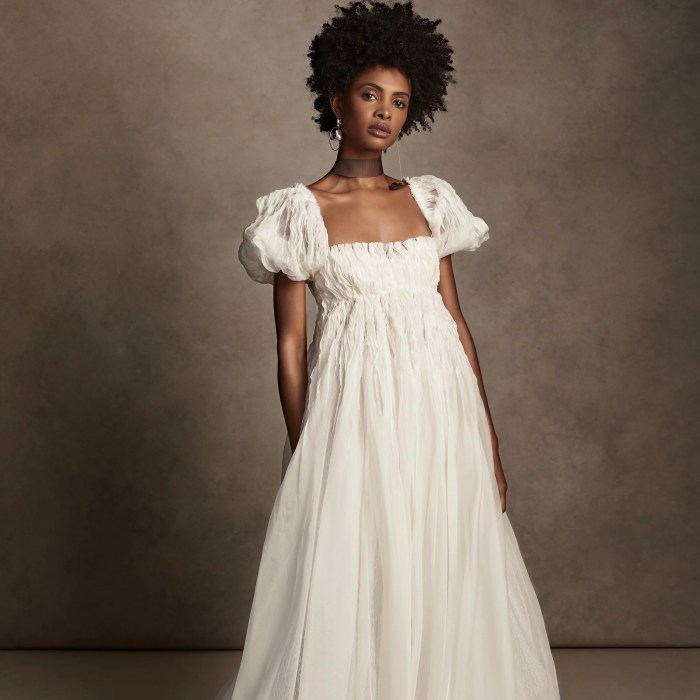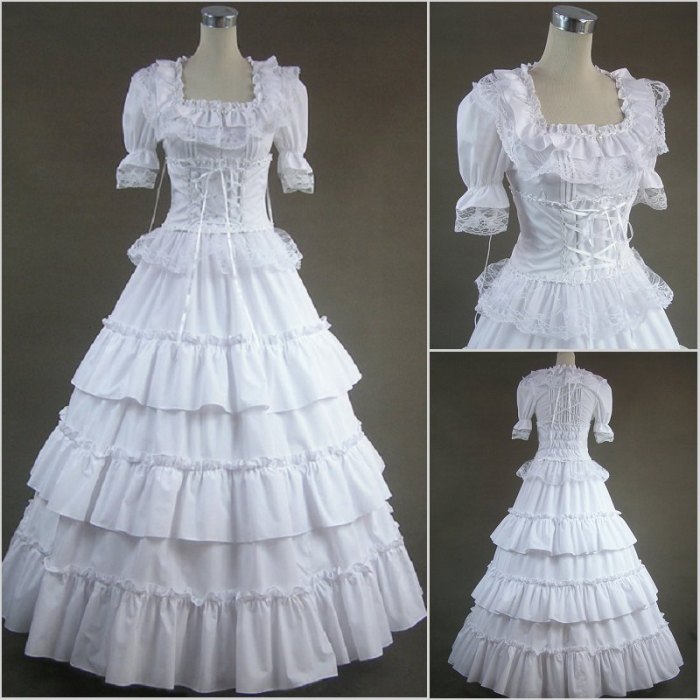The Alluring History of the White Victorian Wedding Dress
The iconic image of a bride in a flowing white gown is deeply rooted in Victorian-era traditions. While the concept of a white wedding dress wasn’t entirely novel, the Victorian period solidified its position as the quintessential bridal attire, transforming it from a simple garment into a powerful symbol of purity, wealth, and social standing. This exploration delves into the fascinating evolution of the white Victorian wedding dress, examining its historical context, construction, styles, accessories, and lasting influence on modern bridal fashion.
Historical Context of White Victorian Wedding Dresses
Before the Victorian era, wedding attire varied greatly depending on social class and regional customs. Brides often wore their best dresses, which could be of any color, depending on availability and preference. The rise of white as the preferred color for wedding dresses was a gradual process, influenced by several factors. Queen Victoria’s choice of a white satin gown for her marriage to Prince Albert in 1840 played a pivotal role in popularizing white as the color of bridal attire.
This choice, coupled with the growing romanticization of marriage and the burgeoning middle class, contributed to the widespread adoption of white wedding dresses across different social strata. However, the association of white with purity and virginity was already present in some cultures, and Victoria’s choice simply amplified this existing symbolism.
Social class significantly impacted the style and extravagance of Victorian wedding dresses. Wealthy brides could afford luxurious fabrics like silk, satin, and lace, often adorned with intricate embroidery and beading. In contrast, working-class brides wore simpler dresses, perhaps made from cotton or linen, with less elaborate embellishments. This difference in attire reflected the stark economic disparities of the era and the social significance placed on a wedding as a public display of wealth and status.
The symbolism of white in Victorian wedding attire was multifaceted. While often interpreted as representing purity and virginity, it also conveyed ideas of innocence, new beginnings, and the bride’s status as a blank slate ready to embark on a new chapter in her life. The choice of white, therefore, went beyond mere aesthetics; it held profound social and symbolic weight.
Fabrics and Construction Techniques
Victorian wedding dresses showcased a variety of luxurious fabrics and meticulous construction techniques. The choice of fabric often reflected the bride’s social standing and the overall opulence of the wedding. Common materials included silk, satin, lace, and sometimes even velvet or brocade for richer embellishments. These fabrics were carefully selected for their drape, texture, and ability to hold intricate detailing.
Construction involved complex techniques. Seams were meticulously hand-stitched, often employing invisible stitches for a flawless finish. Corsets were fundamental to achieving the desired silhouette, shaping the waist and creating a defined form. Embellishments like lace, embroidery, and beading were painstakingly applied, often by hand, adding layers of detail and visual interest to the dresses.
| Fabric Name | Texture | Common Use in Wedding Dress | Durability |
|---|---|---|---|
| Silk | Smooth, lustrous | Bodice, skirt, train | Moderate; prone to snags |
| Satin | Smooth, glossy | Bodice, skirt | Moderate; can wrinkle |
| Lace | Delicate, intricate | Sleeves, bodice overlay, trim | Low; delicate and easily damaged |
| Linen | Slightly coarse, crisp | Underlayers, simpler dresses | High; strong and durable |
Lace, a particularly popular embellishment, came in various forms, from delicate Valenciennes lace to heavier Chantilly lace. Intricate embroidery, often featuring floral motifs or geometric patterns, added another layer of ornamentation. Beading, typically using pearls or glass beads, was used to create shimmering accents and highlight specific design elements.
Silhouettes and Styles
Victorian wedding dresses showcased a variety of silhouettes that evolved throughout the period. Popular styles included the A-line, empire waist, and bustle styles, each reflecting the prevailing fashion trends of the time. These silhouettes were further emphasized by the use of corsetry and strategically placed padding or crinolines.
Sleeve styles ranged from long, flowing sleeves to short puffed sleeves or even sleeveless designs, depending on the specific fashion trends and the bride’s personal preference. Necklines varied from high, closed necklines to lower, more revealing styles. Skirt lengths generally fell to the floor, often featuring a train that added drama and elegance to the overall look. The length and shape of the train also varied depending on the social status of the bride and the prevailing fashion trends.
- Early Victorian (1837-1850s): Emphasis on a slim, elongated silhouette with a fitted bodice and a full skirt, often achieved with a crinoline.
- Mid-Victorian (1850s-1870s): The crinoline gave way to the bustle, creating a fuller skirt with a pronounced fullness at the back.
- Late Victorian (1870s-1900): The bustle became more pronounced and elaborate, creating an exaggerated silhouette. The use of trains and decorative elements also increased.
Three Distinct Victorian Wedding Dress Styles:
1. Crinoline Gown (1850s): Characterized by a full, bell-shaped skirt supported by a crinoline cage, this style created a dramatic, wide silhouette. The bodice was typically fitted and often featured a sweetheart neckline or a high neckline with delicate lace.
2. Bustle Gown (1870s-1880s): This style featured a dramatically full skirt with padding or boning creating a pronounced fullness at the back. The bodice was fitted and often featured a long, pointed waistline. Elaborate lace, embroidery, and beading were common embellishments.
3. S-Bend Gown (1890s): This style showcased a more natural, flowing silhouette with a curved, S-shaped waistline created by corsetry. The skirt was less full than in previous decades, with a more streamlined shape. Long sleeves and high necklines were common features.
Accessories and Adornments

Source: popsugar-assets.com
Victorian wedding dresses were complemented by a variety of accessories that added to their overall elegance and symbolic significance. Veils, gloves, and jewelry were essential components of the bridal ensemble, each carrying its own meaning and reflecting the prevailing social customs.
Veils, often made of lace or tulle, varied in length and style. A long veil symbolized modesty and purity, while a shorter veil could indicate a more modern or less traditional approach. Headpieces, such as floral crowns or jeweled tiaras, were also popular choices. Gloves, typically made of silk or kid leather, were considered essential and often matched the color of the dress or other accessories.
Jewelry styles reflected the opulent tastes of the Victorian era. Cameos, pearls, and diamond jewelry were particularly popular, with elaborate necklaces, earrings, and brooches adding a touch of luxury to the bridal attire. The choice of jewelry could also reflect the bride’s social status and personal preferences.
A typical Victorian bridal ensemble might include a white silk satin gown with a fitted bodice, a full bustle skirt, and long lace sleeves. The bride would wear a long tulle veil, silk gloves, and a delicate pearl necklace and earrings. Her hair would be styled in an elaborate updo, adorned with flowers or a jeweled comb.
Modern Interpretations of the Victorian Wedding Dress

Source: fanpop.com
Modern designers continue to draw inspiration from the elegance and romance of Victorian wedding dresses, adapting key elements to create contemporary gowns that resonate with modern brides. Many modern wedding dresses incorporate Victorian-inspired details such as lace overlays, high necklines, long sleeves, and corseted bodices, offering a blend of classic and contemporary styles.
Key Victorian design elements frequently incorporated into modern dresses include the use of lace, intricate embroidery, and delicate beading. The romantic and flowing silhouettes of some Victorian styles also remain popular, albeit often with a more streamlined and less structured approach. The use of structured corsetry is also seen in some modern designs, providing shape and definition to the bodice.
Comparing a traditional Victorian wedding dress with a modern interpretation reveals the evolution of bridal fashion. While modern dresses may retain some Victorian elements, they often feature a more simplified construction, lighter fabrics, and a greater emphasis on comfort and ease of movement. The focus on pure white has also softened, with ivory and other off-white shades becoming increasingly popular.
The evolution of the sleeve, for example, showcases this adaptation. Victorian dresses often featured long, full sleeves or dramatic puffed sleeves. Modern interpretations might incorporate long sleeves, but often with a more fitted or flowing style, rather than the elaborate structure of their Victorian counterparts. Similarly, necklines have evolved, with high necklines often being adapted into more modern interpretations with less structure and embellishment.
FAQ Overview: White Victorian Wedding Dress
What were some less common colors used for Victorian wedding dresses?
While white became the dominant color, women of lower social classes might wear dresses in other colors, depending on available fabrics and resources. These could include shades of cream, beige, or even darker colors.
How did the availability of fabrics impact Victorian wedding dress designs?
The availability and cost of fabrics like silk, satin, and lace significantly influenced the design and embellishment of Victorian wedding dresses. More expensive fabrics allowed for greater detail and complexity.
Were there regional variations in Victorian wedding dress styles?
Yes, regional variations existed, reflecting local traditions and the availability of materials. Styles in rural areas might differ from those in larger cities.
What happened to Victorian wedding dresses after the wedding?
Often, the wedding dress was repurposed for other occasions or taken apart for its fabric to be used in other garments. Preserving the entire dress as a keepsake was less common than it is today.